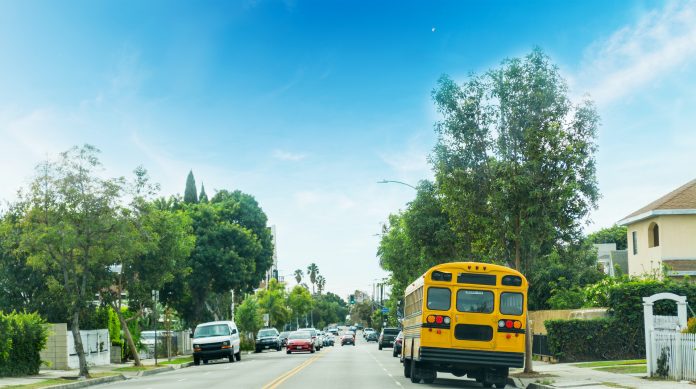As school buses prepare to roll again for the new school year, the state’s $170 billion education budget signed into law by Gov. Gavin Newson in June will provide district school transportation operations with up to 60 percent reimbursement of all home-to-school transportation costs.
“Historic, epic,” Mathew Thomas, the transportation director for Garden Grove Unified School District in Southern California, commented to School Transportation News on the increase. Thomas is also the president of the California Association of School Transportation Officials (CASTO), and he said the organization has been pushing for more funding for years.
Tim Purvis, the CEO at consultant Pupil Transportation Information, noted that the budget increase is the largest stimulus for the California industry in decades. California funding for school transportation was slashed in the early 1980s. Proposition 98 was passed in 1988 to require minimum funding for K-12 education, and funding has remained at the minimum level for transportation.
The final budget provides $637 million in ongoing Proposition 98 general fund money to the Home to School Transportation program local control funding formula add-on. This allows education agencies (LEAs) to receive 60 percent reimbursement of their transportation costs, or their current add-on, plus ongoing cost of living adjustments (COLA).
LEAs must develop a plan for how they will provide transportation services to their students, prioritizing low-income and those in transitional kindergarten through sixth grade.
The budget also provides $1.5 billion in one-time Proposition 98 funds to the California Energy Commission and California Air Resources Board to administer a zero-emission school bus program that will prioritize low-income and rural LEAs and LEAs purchasing electric school buses with bi-directional charging.
The final budget encompasses aspects of AB 2933, which called for school districts to be reimbursed 100 percent of their transportation costs, and SB 878 which would have required school districts to offer free school transportation to all students.
AB 2933, introduced by Assemblyman Patrick O’Donnell and backed by the California School Boards Association (CSBA), would have provided 100-percent reimbursement and an annual cost-of-living adjustment to districts for home-to-school transportation service, but it would allow school districts to choose to receive the additional funding or rely solely on local revenues. Meanwhile, SB 878, introduced by Sen. Nancy Skinner, would have essentially required all students statewide to be eligible for school busing. It would have also prohibited school districts from earning revenues by selling bus passes.
Instead, budget trailer bills AB 181 and AB 182, which were signed by Newsom on June 30, requires the state to reimburse LEAs for 60 percent of home-to-school-transportation costs, reportedly double the current average of 30 percent.
“All told, the budget increases funding for home-to-school transportation by $637 million in ongoing Proposition 98 funding, adds $1.5 billion in one-time Proposition 98 funding for a state-wide zero-emissions school bus program that prioritizes rural and low-income LEAs, and provides an annual cost-of-living adjustment (COLA) equal to 60 percent of an LEA’s transportation costs,” a CSBA press release stated.
Thomas noted that he testified before lawmakers on SB 878, noting that California is the least funded state for school transportation in the nations based on per capita student enrollment, and also has the least ridership at under 10 percent.
“Sixty-percent of funding for home to school transportation, is going to benefit school districts greatly,” Mathew said, noting that Garden Grove’s total district budget is approximately $22 million, which means transportation will get around $13 million with the passage of the new bill. “That’s huge, with fuel costs and everything rising constantly. That’s going to mean more money for the classroom versus just putting it in our general fund for transportation.”
He noted that he foresees districts with lower starting salaries raising pay to attract new school bus drivers. He also noted that the increase of funding might bring back certain routes that were cut as well as offer transportation to more general education students, which is not required in California.
Related: California District Shares Tips for Electric School Bus Operations
Related:California’s Twin Rivers Unified Wins ACT Expo Fleet Award
Related: California School District Converts Half of Fleet to Electric Buses
Meanwhile, Purvis, who retired as the transportation director for Poway Unified School District last month, said the passage of the law still comes with lots of questions.
He said that he and his team at Pupil Transportation Information have interpreted the law to mean that any LEA in California performing pupil transportation, including non-mandated home to school transportation, can be funded up to 60 percent of their expenses for the year completed.
“At this time, it appears that an LEA’s 2021-22 audited actuals will be used as the base line for the 2022-23 expense,” he advised. “One should assure that as they close their financials books currently underway that they are capturing all pupil transportation related expense in budget 3600.”
Purvis explained that Function 3600 is where pupil transportation expense is tracked in a district budget.
“It is especially important that [districts] get it all in Function 3600 as they close their 2021-2022 budgets, as this is where the state will track for their expense,” he added. “Districts are closing out their budgets for last year now, so this reminder is very timely and helpful to them.”
He said he anticipates the Department of Finance releasing an accounting formula. However, he noted that it’s going to be more important than ever for LEAs to separate their expenses and fully understand the costs related to general education and special education. Purvis stressed the need for all LEAs to assure they are capturing all pupil transportation related expense that may currently reside in other budget locations within their budget.
Purvis referenced the information he received from CASTO, School Services of California, and the California 2023 Budget, and questioned if the use of the term “general fund” for home to school transportation. He said sometimes, that means the non-mandated general education transportation, and other times its more generic and is all the pupil transportation related expenses for both general education and special education.
“But that’s a big question,” Purvis said, adding that there’s going to have to be trailer bill language. “Plus, the ongoing COLA, which is really big, too, so there will be a COLA adjustment every year thereafter as well. How will that look? I don’t know.”
Another question to be answered relates to prioritized transportation for low-income and transitional kindergarten students who live within a mile of school. Generally, school bus ridership rules require students to live more than two miles from their school to be eligible. “That’s a massive question right there,” he said. “[A] huge question.”
He noted, however, that the budget language does not state whether distance from school matters.
The budget also requires the governing board to adopt the plan on or before April 1, 2023, and to update it by April 1 each year thereafter. It also prohibits LEAs from charging a fee for unduplicated pupils.
Purvis interpreted this to mean that those identified as economically disadvantaged would not be charged a fee. However, districts would still be allowed to charge all other persons.
“So, we’re kind of celebrating that piece in Poway because it left our fee model in place,” he said.
Related: California School Bus Driver Recognized for Dedication to Job
Related: School Bus Driver, Mechanic Among California Classified School Employees of Year


















